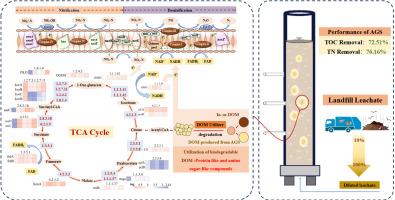Unraveling the Mechanism of Dissolved Organic Matter in Enhancing Nitrogen Removal from Leachate Wastewater Treatment via Aerobic Granular Sludge Process
IF 12.4
1区 环境科学与生态学
Q1 ENGINEERING, ENVIRONMENTAL
引用次数: 0
Abstract
The aerobic granular sludge (AGS) process has emerged as a viable alternative to landfill leachate treatment. The mechanisms by which dissolved organic matter (DOM) in landfill leachate, a potential stimulant, is utilized during treatment with AGS systems remain unclear. In this study, we revealed DOM-mediated nitrogen removal in AGS receiving the effluent from up-flow anaerobic sludge blanket (UASB). The results showed that granules were successfully formed with real fresh leachate contents increasing from 10% to 30%. The established AGS bioreactor could achieve good nitrogen removal (76.16% on average) through partial nitrification-denitrification (PND), effectively reducing carbon demand and selectively utilizing DOM from leachate. Fourier transform ion cyclotron resonance mass spectrometry analysis showed the utilization of DOM of aliphatic, protein-like and amino sugar-like compounds with low saturation in situ of leachate. Microbial analysis identified that Thauera and Rhodobacter belong to Proteobacteria as the dominant nitrogen-removing bacteria, and OLB13, OLB12, and Devosia, accounting for 16.11% of the microbial community, are the primary DOM degraders, with significant correlation (p<0.05). High-throughput analysis showed that protein-like and amino sugar-like compounds were the main DOM components used to facilitate PND via diverse metabolic pathways. This study suggests that the critical role of DOM interactions with AGS microbial consortia could shed light on the regulation of nitrogen removal in landfill leachate treatment.

好氧颗粒污泥法处理渗滤液废水中溶解有机物强化脱氮机理研究
好氧颗粒污泥(AGS)工艺已成为垃圾渗滤液处理的可行替代方案。垃圾渗滤液中溶解的有机物(DOM)是一种潜在的兴奋剂,在AGS系统处理过程中被利用的机制尚不清楚。在这项研究中,我们揭示了dom介导的氮在AGS接收上流式厌氧污泥毯(UASB)出水中的去除。结果表明,当真实新鲜渗滤液含量从10%提高到30%时,颗粒形成成功。所建立的AGS生物反应器通过部分硝化-反硝化(PND)可达到较好的脱氮率(平均76.16%),有效降低了碳需求,选择性地利用了渗滤液中的DOM。傅里叶变换离子回旋共振质谱分析表明,DOM在渗滤液中利用了低饱和度的脂肪族、蛋白质样和氨基糖样化合物。微生物分析发现,Thauera和Rhodobacter属于Proteobacteria,是主要的脱氮菌,OLB13、OLB12和Devosia是主要的DOM降解菌,占微生物群落的16.11%,相关性显著(p<0.05)。高通量分析表明,蛋白质样和氨基糖样化合物是通过多种代谢途径促进PND的主要DOM成分。本研究提示DOM与AGS菌群相互作用的关键作用可能对垃圾渗滤液处理中氮去除的调控有一定的启示。
本文章由计算机程序翻译,如有差异,请以英文原文为准。
求助全文
约1分钟内获得全文
求助全文
来源期刊

Water Research
环境科学-工程:环境
CiteScore
20.80
自引率
9.40%
发文量
1307
审稿时长
38 days
期刊介绍:
Water Research, along with its open access companion journal Water Research X, serves as a platform for publishing original research papers covering various aspects of the science and technology related to the anthropogenic water cycle, water quality, and its management worldwide. The audience targeted by the journal comprises biologists, chemical engineers, chemists, civil engineers, environmental engineers, limnologists, and microbiologists. The scope of the journal include:
•Treatment processes for water and wastewaters (municipal, agricultural, industrial, and on-site treatment), including resource recovery and residuals management;
•Urban hydrology including sewer systems, stormwater management, and green infrastructure;
•Drinking water treatment and distribution;
•Potable and non-potable water reuse;
•Sanitation, public health, and risk assessment;
•Anaerobic digestion, solid and hazardous waste management, including source characterization and the effects and control of leachates and gaseous emissions;
•Contaminants (chemical, microbial, anthropogenic particles such as nanoparticles or microplastics) and related water quality sensing, monitoring, fate, and assessment;
•Anthropogenic impacts on inland, tidal, coastal and urban waters, focusing on surface and ground waters, and point and non-point sources of pollution;
•Environmental restoration, linked to surface water, groundwater and groundwater remediation;
•Analysis of the interfaces between sediments and water, and between water and atmosphere, focusing specifically on anthropogenic impacts;
•Mathematical modelling, systems analysis, machine learning, and beneficial use of big data related to the anthropogenic water cycle;
•Socio-economic, policy, and regulations studies.
 求助内容:
求助内容: 应助结果提醒方式:
应助结果提醒方式:


